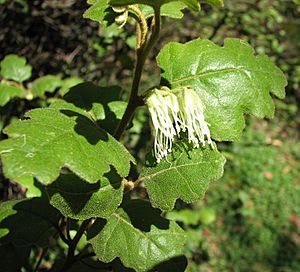Karri oak facts for kids
Quick facts for kids Karri oak |
|
|---|---|
 |
|
| Chorilaena quercifolia in Karwarra Gardens | |
| Scientific classification | |
| Genus: |
Chorilaena
|
| Species: |
quercifolia
|
| Synonyms | |
The Karri oak (scientific name: Chorilaena quercifolia) is a special type of bushy shrub. It is found only in the beautiful Karri forests of south-west Western Australia. This plant is the only species in its group, called Chorilaena.
It has unique leaves that feel like paper and are shaped a bit like an egg. The edges of the leaves are lobed, meaning they have rounded sections. Its flowers come in different colors and grow in clusters of five. The outer parts of the flowers, called sepals and petals, are hairy. The stamens, which are the parts that hold pollen, stick out beyond the petals.
Contents
Discovering the Karri Oak's Features
What Does the Karri Oak Look Like?
The Karri oak is a bushy shrub that usually grows to be about 1 to 4 meters (3 to 13 feet) tall. It can spread out to be 1 to 3 meters (3 to 10 feet) wide.
Its leaves are thin and feel like paper. They are shaped broadly like an egg and are usually 30 to 55 millimeters (1.2 to 2.2 inches) long. Each leaf sits on a thin stem called a petiole, which is about 10 millimeters (0.4 inches) long.
Karri Oak Flowers and How They Grow
The flowers of the Karri oak are often green, but you might also see them in yellow, white, red, or pink. They grow in clusters of five, arranged like an umbrella. This cluster hangs down from a stalk called a peduncle, which is about 10 millimeters long.
The flower in the very center of the cluster has no stalk of its own. The other four flowers grow on small, spreading stalks called pedicels, which are about 4 millimeters long.
At the bottom of the sepals, there are small, leaf-like parts called bracts and bracteoles. These are about the same length as the flowers. The sepals are joined at their base and have narrow, triangular tips about 6 millimeters long. They are covered on the outside with soft, star-shaped hairs.
The petals are shaped like oblongs or ellipses and are 7 to 8 millimeters long. They also have star-shaped hairs on their outer surface. The stamens, which are the parts that produce pollen, are two to three times longer than the petals.
The Karri oak mainly blooms, or flowers, between October and February.
Naming the Karri Oak
How the Karri Oak Got Its Name
The Karri oak was first officially described in 1837 by a botanist from Austria named Stephan Endlicher. He wrote about it in his book, Enumeratio plantarum quas in Novae Hollandiae ora austro-occidentali ad fluvium Cygnorum et in sinu Regis Georgii collegit Carolus Liber Baro de Hügel.
Endlicher based his description on plants collected near King George Sound by Charles von Hügel. The scientific name quercifolia comes from the Latin words for "oak leaf." This is because the Karri oak's leaves look similar to those of an oak tree, which belongs to the genus Quercus.
Where the Karri Oak Lives
Karri Oak's Home and Environment
The Karri oak grows in specific places in Western Australia. You can find it on rocky coasts and on hillsides. It usually grows within 60 kilometers (37 miles) of the coast, between Cape Naturaliste and Bald Island.
Karri Oak's Protection Status
Is the Karri Oak Endangered?
Good news! The Government of Western Australia's Department of Parks and Wildlife lists the Karri oak as "not threatened." This means it is not currently at risk of disappearing.
See also
 In Spanish: Chorilaena quercifolia para niños
In Spanish: Chorilaena quercifolia para niños

